Most transportation in Cape Verde is done by air. There are regular flights between the major islands, with less frequent flights to the other islands. Boat transportation is available, though not widely used nor dependable. In the major cities, public bus transport runs periodically, and taxis are common. In smaller towns, there are mostly hiaces and/or taxis.
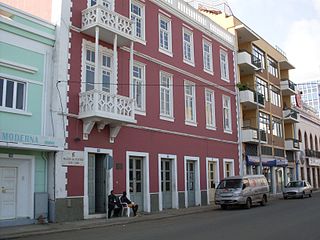
Praia is the capital and largest city of Cape Verde. Located on the southern coast of Santiago island, within the Sotavento Islands group, the city is the seat of the Praia Municipality. Praia is the political, economic and cultural center of Cape Verde.

Boa Vista, sometimes incorrectly spelled Boavista, is a desert-like island that belongs to the Cape Verde Islands. At 631.1 km2 (243.7 sq mi), it is the third largest island of the Cape Verde archipelago.
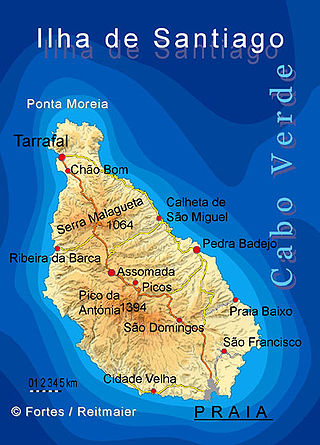
Santiago is the largest island of Cape Verde, its most important agricultural centre and home to half the nation's population. Part of the Sotavento Islands, it lies between the islands of Maio and Fogo. It was the first of the islands to be settled: the town of Ribeira Grande was founded in 1462. Santiago is home to the nation's capital city of Praia.

Santa Catarina is a concelho (municipality) of Cape Verde. It is situated in the western part of the island of Santiago. Its seat is the city of Assomada. Its population was 45,920 in 2017 (estimate). Its area is 242.6 km2 (93.7 sq mi).
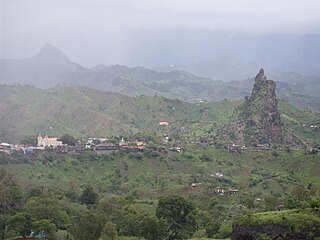
Picos, also known as Achada Igreja, is a city in the central part of the island of Santiago, Cape Verde. It is the seat of São Salvador do Mundo municipality. Picos is located 4 km southeast of Assomada and 23 km northwest of the capital city of Praia, near the national road from Praia to Tarrafal via Assomada (EN1-ST01).
Figueira das Naus is a settlement in the western part of the island of Santiago, Cape Verde. It is part of the municipality of Santa Catarina. In 2010 its population was 1,157. It is situated 11 km south of Tarrafal and 12 km northwest of Assomada. It is situated on the secondary road connecting Fundura and Ribeira da Prata.
The Museu da Tabanca is a museum in the town Chã de Tanque in the western part of the island of Santiago in Cape Verde. It is dedicated to local culture, including tabanka music. The museum was first opened in 2000 in Assomada, the seat of the municipality of Santa Catarina, but in December 2008 it was moved to its current location in Chã de Tanque, also part of Santa Catarina. After two years of renovation, it was reopened in November 2017.
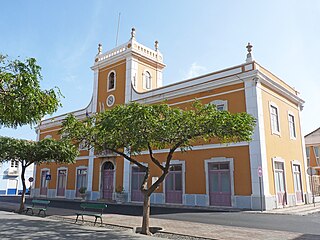
Praia is a concelho (municipality) of Cape Verde. It is situated in the southern part of the island of Santiago. Its seat is the city Praia, the capital of Cape Verde. Its area is 120.6 km2 (46.6 sq mi), and its population was 131,719 at the 2010 census. The municipality consists of one freguesia, Nossa Senhora da Graça. The city hall is located in the Platô part of the city.

Primary school education in Cape Verde is mandatory between the ages of 6–14 and free for children ages 6–12. In 1997, the gross primary enrollment rate was 148.8%. Primary school attendance rates were unavailable for Cape Verde as of 2001. While enrollment rates indicate a level of commitment to education, they do not always reflect children's participation in school. Textbooks have been made available to 90% of school children, and 90% of teachers have attended in-service teacher training. Its literacy rate as of 2010 ranges from 75 to 80%, the highest in West Africa south of the Sahara.
Tabanka is a musical genre of Cape Verdean music.

Tarrafal is a city in the northern part of the island of Santiago, Cape Verde. In 2010 its population was 6,656. It is a fishing port situated on the northwestern coast. It constitutes the seat of the Tarrafal Municipality.
Silvino Lopes Évora is a Cape Verdean writer, poet, journalist and a university professor.
Manuel Veiga is a Cape Verdean writer, a linguist with references in the national and international level and a politician. He was minister of culture of his country from 2004 to 2011.
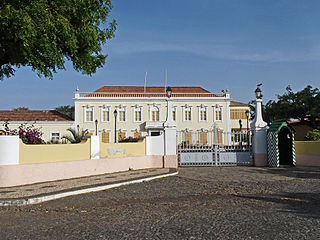
Plateau is the historic centre of the capital city of Praia on the island of Santiago, Cape Verde. It gets its name because it is situated on a plateau overlooking the port of Praia. Its average elevation is 37 meters above sea level. The population of Plateau was 1,019 at the 2010 census. Many public buildings are situated in Plateau, notably the Presidential Palace, the cathedral, the city hall and the Ethnographic Museum.
Chã de Tanque is a town in the west-central part of the island of Santiago, Cape Verde. It is part of the municipality of Santa Catarina. In 2010 its population was 1,164. It is situated 4 km west of Assomada, on the road to Rincão. The elevation is about 260 meters above sea level. Since 2008, it is home to the Museu da Tabanca.

The following is a timeline of the city of Praia, capital of Cape Verde.

Avenida Amílcar Cabral is an avenue in the Plateau, the historic centre of Praia, Santiago island, Cape Verde. It is the neighborhood's longest street and the main artery of the city centre. Formerly named Rua Sá da Bandeira after 19th century Portuguese politician Sá da Bandeira, it was renamed after Cape Verdean independence in honour of Amílcar Cabral, leader of the independence movement of Cape Verde and Guinea-Bissau. It runs south to north in the western part of the Plateau, parallel to Rua 5 de Julho, Rua Serpa Pinto and Avenida Andrade Corvo. It forms the west side of Praça Alexandre Albuquerque.
The Culture of the Island of Santiago, Cape Verde is the richest in the nation, with a range of customs and practices common in the islands,
Estádio de Cumbém, also as Estádio Municipal de Cumbém is a multi-purpose stadium in the city of Assomada, seat of the municipality of Santa Catarina in the Santiago, Cape Verde and is located in the suburb of Cumbém located south of the centre, accessed with Avenida 15 de Dezembro. It is one of four that are operated by the Santiago North Regional Football Association (ARFSN) and serves as its headquarters of the North Zone. The stadium is home to Assomada's best clubs including Desportivo de Assomada, the top five of the North Zone and Juventude Assomada, clubs based in Assomada's neighborhoods includes Associação Nhágar e Boa Entrada, Esperança FC, Grémio Nhágar and Inter Cutelo Salinas, clubs based in the municipality is Portas Abertas, clubs based outside Santa Catarina is União Picos from São Salvador do Mundo. A former club played at the stadium included Os Amigos and Juventude de Assomada. All clubs participate in the Santiago Island League North Zone

















